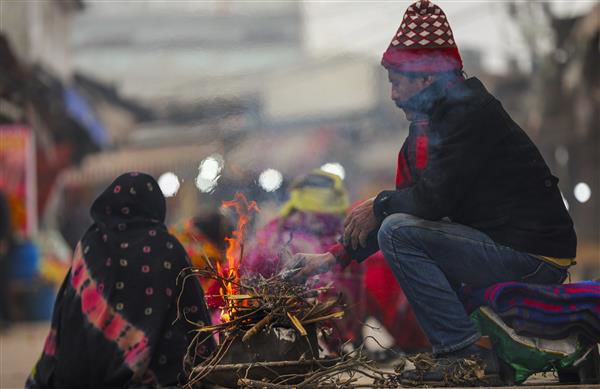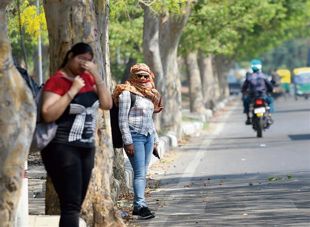
A man sits near a bonfire to warm himself during a cold winter morning in Jammu on Friday. PTI
Vibha Sharma
Chandigarh, January 12
For the people braving the biting cold in the northwest, some relief appears to be around the corner.
According to the IMD, dense to very dense fog conditions are likely to continue over north India in the next five days. Cold day to severe cold day wave conditions are also expected to prevail over plains of northwest India for the next three days.
The good news is that there is a possibility of reduction in cold wave conditions thereafter.
“Cold wave to severe cold wave conditions are expected to continue in isolated pockets of Punjab, Haryana, Chandigarh and Delhi till Saturday and cold wave conditions in isolated pockets till January 14.
"Cold day to severe cold day wave conditions are likely over plains of northwest India during next three days and reduction thereafter,” the weather office said.
Cold wave
So what is bringing the change?
The IMD says a Western Disturbance is present as a trough in middle tropospheric westerlies under the influence of which light rainfall/snowfall at isolated places is expected over Jammu Kashmir-Ladakh-Gilgit-Baltistan-Muzaffarabad and Himachal Pradesh on Friday and Saturday.
Meanwhile, a fresh WD is expected to arrive around January 16 over the Western Himalayan Region under the influence of which light rainfall/snowfall at isolated places is “very likely over Jammu-Kashmir-Ladakh-Gilgit-Baltistan-Muzaffarabad and Himachal Pradesh on January 16 and 17 and Uttarakhand on January 17 and 18.
One of the major factors contributing to colder-than-normal temperatures over north India during this time of the year is the largescale fog cover lasting for long durations, which prevents the sunlight from reaching the surface.
There is no heating from the sun during the daytime and chilly winds from the mountains add to the overall effect. Usually, foggy or cloudy nights are associated with warmer nights. However, if the fog persists for longer periods, there is also cooling in the night.
Association with WD
Normally, a prolonged cold wave spell in plains of the northwest is due to a large gap between two WDs.
The long gap allows chilly northwesterly winds from mountains to affect plains for longer times, leading to fog, absence of sun for longer duration and radiation imbalance. In the ongoing winter season, WDs have been few and far between, a reason why north India has also mostly remained dry.
Basically, WDs affecting north India are weather systems originating in the Mediterranean region. Coming from outside the tropical region, the disturbance, or the area of reduced air pressure, travels from the western to the eastern direction, bringing rain and snow upon its arrival in the Western Himalayan Region.
Good for wheat and other rabi crop, rain also adds to soil moisture and replenishes groundwater and water bodies.
Usually when a weather system associated with warm moist winds inflows, wind direction changes and chilly northwesterly winds from mountains stop, leading to increase in temperatures and abatement of cold wave conditions.
Temperatures below normal
Currently, minimum temperatures range from 3-7° Celsius over most parts of Punjab, Haryana, Chandigarh, Delhi, Rajasthan, parts of Uttar Pradesh, south Rajasthan, north Madhya Pradesh and in isolated pockets of Bihar.
They are below normal by -1.0° C to -3.0° C at many places, as per the IMD.
Today, the lowest minimum temperature of 1.4°C was reported at Amritsar.
Cold wave to severe cold wave conditions prevailed in isolated pockets of east Rajasthan, Punjab and cold wave conditions prevailed in isolated pockets of Haryana and West Rajasthan, it said.
Very dense fog (visibility < 50 metres) was also observed during morning hours in most parts of Punjab, in many parts of Haryana, Chandigarh, Delhi, in some parts of Uttar Pradesh, isolated pockets of Jammu division and north Madhya Pradesh.
Cold wave warning
Meanwhile, a gradual fall by 2-3°C in minimum temperatures is predicted over Central and East India in the next two to three days.
Join Whatsapp Channel of The Tribune for latest updates.




























